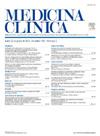Utilidad pronóstica de valores extremos de NT-proBNP en pacientes ingresados por insuficiencia cardíaca
IF 2.6
4区 医学
Q1 MEDICINE, GENERAL & INTERNAL
引用次数: 0
Abstract
Background and objective
To evaluate the prognostic value of extreme levels of the N-terminal pro-brain natriuretic peptide (NT-proBNP) measured at any time during hospitalization for heart failure (HF).
Materials and methods
A retrospective cohort study including patients hospitalized for HF in a secondary-level hospital with at least one NT-proBNP measurement. Two groups were defined: patients with extreme NT-proBNP levels (> 50,000 pg/mL) and those with elevated NT-proBNP levels (> 1800 pg/mL and < 20,000 pg/mL). The primary outcome was a composite of (1) in-hospital mortality; (2) HF readmission, and (3) 6-month mortality. Cox survival models were used for analysis.
Results
A total of 83 patients with extreme NT-proBNP levels and 100 with elevated NT-proBNP levels were included; 61% were women, with a median age of 87 years. Comorbidity burden was high and similar between groups (median Charlson index: 8). The primary outcome was more frequent in patients with extreme NT-proBNP levels: 25.02 vs. 10.53 events per 100 patient-months (HR 2.07; 95% CI: 1.37-3.14). Both in-hospital and 6-month mortality were significantly higher in the extreme NT-proBNP group, while HF readmissions were numerically higher but not statistically significant. These results remained consistent after multivariable adjustment.
Conclusions
Patients hospitalized for HF with NT-proBNP levels > 50,000 pg/mL have a worse prognosis than those with NT-proBNP < 20,000 pg/mL, representing a high-risk subgroup with short-term mortality.
NT-proBNP极值对心脏衰竭住院患者的预测效用
背景与目的评价因心力衰竭(HF)住院期间任何时间测量的n端脑利钠肽前体(NT-proBNP)极端水平的预后价值。材料和方法一项回顾性队列研究,纳入至少有一项NT-proBNP测量的二级医院心衰住院患者。分为两组:NT-proBNP水平极端的患者(>;50,000 pg/mL)和NT-proBNP水平升高的患者(>;1800 pg/mL和<;20000 pg / mL)。主要终点是以下综合指标:(1)住院死亡率;(2) HF再入院,(3)6个月死亡率。采用Cox生存模型进行分析。结果共纳入NT-proBNP极端患者83例,NT-proBNP升高患者100例;61%为女性,中位年龄为87岁。两组共病负担高且相似(Charlson指数中位数:8)。主要结局在NT-proBNP水平极端的患者中更为常见:25.02 vs 10.53事件/ 100患者-月(HR 2.07;95% ci: 1.37-3.14)。极端NT-proBNP组的住院死亡率和6个月死亡率均显著高于极端NT-proBNP组,而HF再入院率在数字上较高,但无统计学意义。这些结果在多变量调整后保持一致。结论心衰住院患者NT-proBNP水平与gt;50,000 pg/mL的预后较NT-proBNP和lt患者差;20000 pg/mL,属于短期死亡率高的高危亚组。
本文章由计算机程序翻译,如有差异,请以英文原文为准。
求助全文
约1分钟内获得全文
求助全文
来源期刊

Medicina Clinica
医学-医学:内科
CiteScore
3.10
自引率
5.10%
发文量
295
审稿时长
22 days
期刊介绍:
Medicina Clínica, fundada en 1943, es una publicación quincenal dedicada a la promoción de la investigación y de la práctica clínica entre los especialistas de la medicina interna, así como otras especialidades. Son características fundamentales de esta publicación el rigor científico y metodológico de sus artículos, la actualidad de los temas y, sobre todo, su sentido práctico, buscando siempre que la información sea de la mayor utilidad en la práctica clínica.
 求助内容:
求助内容: 应助结果提醒方式:
应助结果提醒方式:


